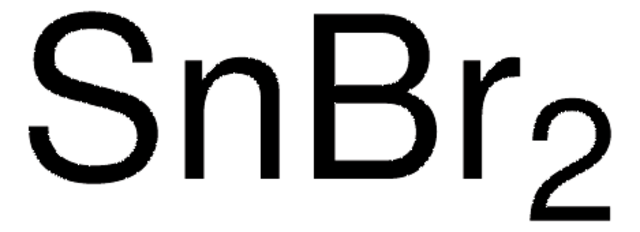203017
Cesium bromide
99.999% trace metals basis
Synonim(y):
Cesium monobromide
About This Item
Polecane produkty
Próba
99.999% trace metals basis
Postać
powder and chunks
zanieczyszczenia
≤15.0 ppm Trace Metal Analysis
mp
636 °C (lit.)
gęstość
4.44 g/mL at 25 °C (lit.)
ciąg SMILES
[Br-].[Cs+]
InChI
1S/BrH.Cs/h1H;/q;+1/p-1
Klucz InChI
LYQFWZFBNBDLEO-UHFFFAOYSA-M
Szukasz podobnych produktów? Odwiedź Przewodnik dotyczący porównywania produktów
Powiązane kategorie
Opis ogólny
Zastosowanie
- An electrolyte additives to improve the cycling efficiency of lithium and graphite anodes in lithium-ion batteries. The cesium cations can help control the interfacial chemistry on the anode, leading to enhanced performance.
- An additive to enhance the efficiency and stability of CsPbI2Br perovskite solar cells by passivating defects, improving charge transport properties, and contributing to higher power conversion efficiencies.
- As a precursor material to synthesize cesium lead bromide (CsPbBr3) perovskite, which is then utilized as an electrode material in a symmetric supercapacitor.
- As a precursor to prepare thermal neutron imaging plates.
- As a precursor to synthesize lead-free CsBr: Eu2+ nanocrystals for fabricating white LEDs.
- As an additive to prepare CsI-based scintillators. Alloying with cesium bromide increases the yield limit and microhardness of CsI crystals.
Hasło ostrzegawcze
Warning
Zwroty wskazujące rodzaj zagrożenia
Zwroty wskazujące środki ostrożności
Klasyfikacja zagrożeń
Acute Tox. 4 Oral - Aquatic Acute 1 - Repr. 2
Kod klasy składowania
13 - Non Combustible Solids
Klasa zagrożenia wodnego (WGK)
WGK 3
Temperatura zapłonu (°F)
Not applicable
Temperatura zapłonu (°C)
Not applicable
Środki ochrony indywidualnej
dust mask type N95 (US), Eyeshields, Gloves
Certyfikaty analizy (CoA)
Poszukaj Certyfikaty analizy (CoA), wpisując numer partii/serii produktów. Numery serii i partii można znaleźć na etykiecie produktu po słowach „seria” lub „partia”.
Masz już ten produkt?
Dokumenty związane z niedawno zakupionymi produktami zostały zamieszczone w Bibliotece dokumentów.
Klienci oglądali również te produkty
Produkty
Colloidal quantum dots (CQDs) are semiconducting crystals of only a few nanometers (ca. 2–12 nm) coated with ligand/surfactant molecules to help prevent agglomeration.
Nasz zespół naukowców ma doświadczenie we wszystkich obszarach badań, w tym w naukach przyrodniczych, materiałoznawstwie, syntezie chemicznej, chromatografii, analityce i wielu innych dziedzinach.
Skontaktuj się z zespołem ds. pomocy technicznej












